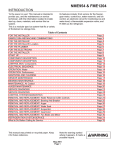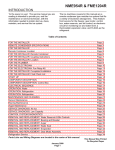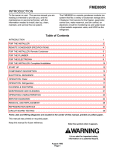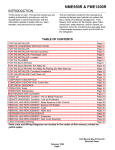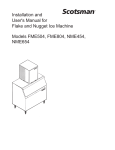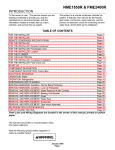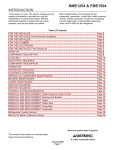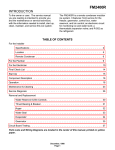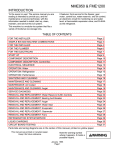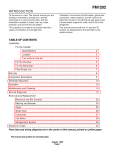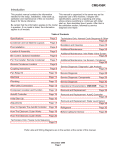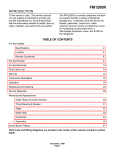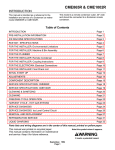Download Scotsman FME804R Service manual
Transcript
NME654R & FME804R INTRODUCTION Scotsman storage bins. Their features include: To the owner or user: The service manual you are front service for the freezer, gearmotor, control reading is intended to provide you, and the box, water reservoir, and bin control; an electronic maintenance or service technician, with the control (AutoSentry) for monitoring ice and water information needed to install, start up, clean, level; a thermostatic expansion valve; and HP62 as maintain, and service this ice system. the refrigerant. The FME804R and NME654R are a remote condenser modular ice systems that fit a variety of Table of Contents FOR THE INSTALLER · · · · · · · · · · · · · · · · · · · · · · · · · · · · · · · · · · · · · · Page 2 FOR THE INSTALLER · · · · · · · · · · · · · · · · · · · · · · · · · · · · · · · · · · · · · · Page 3 REMOTE CONDENSER SPECIFICATIONS · · · · · · · · · · · · · · · · · · · · · · · · · · · Page 4 Remote Condenser Location · · · · · · · · · · · · · · · · · · · · · · · · · · · · · · · · · · · Page 5 FOR THE INSTALLER: Remote Condenser · · · · · · · · · · · · · · · · · · · · · · · · · · · Page 6 FOR THE INSTALLER: Coupling Instructions · · · · · · · · · · · · · · · · · · · · · · · · · · Page 7 FOR THE INSTALLER: Location · · · · · · · · · · · · · · · · · · · · · · · · · · · · · · · · · Page 8 FOR THE PLUMBER · · · · · · · · · · · · · · · · · · · · · · · · · · · · · · · · · · · · · · · Page 9 FOR THE ELECTRICIAN · · · · · · · · · · · · · · · · · · · · · · · · · · · · · · · · · · · · · Page 10 FOR THE INSTALLER: Completed Installation · · · · · · · · · · · · · · · · · · · · · · · · · · Page 11 FOR THE INSTALLER: Final Check List · · · · · · · · · · · · · · · · · · · · · · · · · · · · · Page 12 START UP · · · · · · · · · · · · · · · · · · · · · · · · · · · · · · · · · · · · · · · · · · · · Page 13 COMPONENT DESCRIPTION · · · · · · · · · · · · · · · · · · · · · · · · · · · · · · · · · · Page 14 COMPONENT DESCRIPTION: Control Box · · · · · · · · · · · · · · · · · · · · · · · · · · · Page 15 ELECTRICAL SEQUENCE · · · · · · · · · · · · · · · · · · · · · · · · · · · · · · · · · · · · Page 16 OPERATION: Water · · · · · · · · · · · · · · · · · · · · · · · · · · · · · · · · · · · · · · · Page 17 OPERATION: Refrigeration · · · · · · · · · · · · · · · · · · · · · · · · · · · · · · · · · · · · Page 18 OPERATION: Refrigeration · · · · · · · · · · · · · · · · · · · · · · · · · · · · · · · · · · · · Page 19 OPERATION: Refrigeration · · · · · · · · · · · · · · · · · · · · · · · · · · · · · · · · · · · · Page 20 CLEANING & SANITIZING · · · · · · · · · · · · · · · · · · · · · · · · · · · · · · · · · · · · Page 21 SENSOR MAINTENANCE · · · · · · · · · · · · · · · · · · · · · · · · · · · · · · · · · · · · Page 22 BEARING MAINTENANCE · · · · · · · · · · · · · · · · · · · · · · · · · · · · · · · · · · · · Page 23 AUGER AND OTHER MAINTENANCE · · · · · · · · · · · · · · · · · · · · · · · · · · · · · Page 24 OPERATING CHARACTERISTICS · · · · · · · · · · · · · · · · · · · · · · · · · · · · · · · Page 25 SERVICE DIAGNOSIS: · · · · · · · · · · · · · · · · · · · · · · · · · · · · · · · · · · · · · Page 26 SERVICE DIAGNOSIS: · · · · · · · · · · · · · · · · · · · · · · · · · · · · · · · · · · · · · Page 27 CONTROL SYSTEM DIAGNOSTICS · · · · · · · · · · · · · · · · · · · · · · · · · · · · · · Page 28 REMOVAL AND REPLACEMENT: Water Reservoir & Bin Controls · · · · · · · · · · · · · · · Page 29 REMOVAL AND REPLACEMENT: Bearing And Breaker · · · · · · · · · · · · · · · · · · · · Page 30 REMOVAL AND REPLACEMENT: Auger · · · · · · · · · · · · · · · · · · · · · · · · · · · · Page 31 REMOVAL AND REPLACEMENT: Water Seal · · · · · · · · · · · · · · · · · · · · · · · · · · Page 32 REMOVAL AND REPLACEMENT: Evaporator · · · · · · · · · · · · · · · · · · · · · · · · · · Page 33 REMOVAL AND REPLACEMENT: Gearmotor Assembly · · · · · · · · · · · · · · · · · · · · Page 34 REFRIGERATION SERVICE · · · · · · · · · · · · · · · · · · · · · · · · · · · · · · · · · · · Page 35 Note this symbol when it appears. It is an alert for important safety information on a potential hazard. January 2000 Page 1 NME654R & FME804R FOR THE INSTALLER These machines are designed to fit the following Scotsman storage bins: · SB480 and extensions (with bin top KBT18) · HTB555 or BH550 using bin top KBT14 or KBT20 · BH800 using bin top KBT15 (one unit) or KBT25 (two units). · BH801 using bin top KBT28 · BH900 using bin top KBT24 NME654 Dispenser Applications The NME654 can be placed on and used with certain ice and ice-beverage dispensers. Kits are required for proper operation, see the following list: · ID150, use adapter KBT42 and KNUGDIV · ID200 or ID250, use adapter KBT46 and KDIL-N-ID2 · Cornelius ED/DF200 beverage dispensers, use KBT46 and KDIL-N-200 · Cornelius ED/DF250 beverage dispensers, use KBT46 and KDIL-N-250 · Lancer nugget ice & beverage dispenser, use KDIL-N-L and Lancer kit #82-3491. SPECIFICATIONS: ICE MACHINE Model FME804RS-1A NME654RS-1A Dimensions W" x D" x H" 21" x 24" x 27" same Basic Electrical 115/60/1 same Ice Type FLAKE Nugget Refrigerant Type R-404A R-404A Refrigerant Charge 208 ounces same Min Circuit Ampacity 22.5 same * Minimum Circuit Ampacity is used to determine wire size and type per National Electric Code. May 2006 Page 2 Max Fuse Size 30 same NME654R & FME804R FOR THE INSTALLER Installation Limitations: This ice system is designed to be installed indoors, in a controlled environment: Min. Max. Air Temperature 500F 1000F (Not including the remote condenser) 1000F Water Temperature 400F Water Pressure (psi) 20 80 Voltage -5% +10% (Compared to the nameplate) Operating the machine outside of the limitations is misuse and can void the warranty. Scotsman Ice Systems are designed and manufactured with the highest regard for safety and performance. They meet or exceed the standards of UL, NSF, and CUL. Scotsman assumes no liability or responsibility of any kind for products manufactured by Scotsman that have been altered in any way, including the use of any part and/or other components not specifically approved by Scotsman. Scotsman reserves the right to make design changes and/or improvements at any time. Specifications and design are subject to change without notice. Location After uncrating and inspection, the unit is ready for installation. It is important that the machine be installed in a location where it has enough space around it to be accessible for service, usually a minimum of 6 inches. Try to avoid hot, dirty and crowded locations. Be sure that the location for the machine is within the limitations described. Storage Bin Tip the storage bin on its back, using parts of the carton to protect the exterior finish. Install the legs into the threaded holes in the bottom of the bin. Turn the leg levelers all the way in preparation for leveling later. Return the bin to the upright position, remove paper covering the bin gasket. Install the bin top according to the directions with the bin top. Note: Do not push bin into position, but lift it there. Pushing a bin, especially one with ice in it, can cause damage to the legs and the leg mounts. Ice Maker The machine is heavy, so the use of a mechanical lift is recommended for lifting the machine high enough to install on top of the bin. After the unit is placed on the bin, line it up so it is even with the back side. Secure the machine to the bin with the hardware provided with the machine. Remove the front panel and remove any shipping blocks. Note: Be sure to allow a 6" minimum space above the top of the machine for service. January 2000 Page 3 NME654R & FME804R REMOTE CONDENSER SPECIFICATIONS ERC DIMENSIONS 2.00 5.08 Model ERC101 A 33 3 8" B 10 3 4" F 16 3 4" G 11 5 8" 19.75 50.17 Liquid Line .38 Quick Connect Fitting .95 Discharge Line .50 Quick Connect Fitting 1.27 23 13 16" 2.75 Air Discharge 14.53 Air Intake Adjustable Roof Clearance 12.00 18.00 24.00 30.48 45.72 60.95 2.07 Model ERC101-1 Use with 1 FME804R or 1 NME654R Basic Electrical 115/60/1 19 7 8" RTE25 Precharged line set, 25’, R-404A RTE40. Precharged line set, 40’, R-404A ICEMAKER NAMEPLATE LOCATED ON BACK PANEL SERIAL PLATE LOCATED January 2000 Page 4 .53 (6) 1.35 NME654R & FME804R Remote Condenser Location Use the following for planning the placement of the condenser relative to the ice machine Location Limits - condenser location must not exceed ANY of the following limits: · Maximum rise from the ice machine to the condenser is 35 physical feet · Maximum drop from the ice machine to the condenser is 15 physical feet · Physical line set maximum length is 100 feet. · Calculated line set length maximum is 150. Calculation Formula: · Drop = dd x 6.6 (dd = distance in feet) · Rise = rd x 1.7 (rd = distance in feet) · Horizontal Run = hd x 1 (hd = distance in feet) · Calculation: Drop(s) + Rise(s) + Horizontal Run = dd+rd+hd = Calculated Line Length · Route a line set that rises, then falls, then rises. · Route a line set that falls, then rises, then falls. Calculation Example 1: The condenser is to be located 5 feet below the ice machine and then 20 feet away horizontally. 5 feet x 6.6 = 33. 33 + 20 = 53. This location would be acceptable Calculation Example 2: The condenser is to be located 35 feet above and then 100 feet away horizontally. 35 x 1.7 = 59.5. 59.5 +100 = 159.5. 159.5 is greater than the 150 maximum and is NOT acceptable. 40.35" hd 22.87" Remote Condenser Located ABOVE Ice Machine Configurations that do NOT meet these requirements must receive prior written authorization from Scotsman. Do NOT: 17.15" rd dd Remote Condenser Located BELOW Ice Machine January 2000 Page 5 Condenser Distance and Location Schematic NME654R & FME804R FOR THE INSTALLER: Remote Condenser Location Limited to a 40 foot or a 25 foot length of precharged refrigerant tubing connecting the ice machine to the remote condenser. The condenser must be above or level with the ice machine. Select the best available location, protecting the condenser from extremes of dirt, dust, and sun. Meet all applicable building codes. Usually the services of a licensed electrician are required. Roof Attachment 1. Install and attach the remote condenser to the roof of the building, using the methods and practices of construction that conform to the local building codes, including having a roofing contractor secure the condenser to the roof. 2. Have an electrician connect the remote condenser fan motor to the ice machine, using the junction box at the back of the ice machine. PRECHARGED LINE ROUTING CAUTION Do not connect precharged tubing until all routing and forming of the tubing is complete. See the coupling instructions for connecting information. 1. Each set of precharged refrigerant lines (either 25 foot or 40 foot) consists of a 3/8 inch diameter liquid line and a 1/2 inch diameter discharge line. Both ends of each line have quick connect couplings, one end has a schrader valve connection, that end goes to the condenser. Note: The openings in the building ceiling or wall, listed in the next step, are the minimum sizes recommended for passing the refrigerant lines through. 2. Have the roofing contractor cut a minimum hole for the refrigerant lines of 1 3/4 inch. Check local codes, a separate hole may be required for the electrical power to the condenser. CAUTION DO NOT KINK OR CRIMP REFRIGERANT TUBING WHEN INSTALLING IT. 4. Spiral the excess length of pre charged tubing inside the building. Use a horizontal spiral (need not be as tight as illustrated) to avoid any traps in the lines. 5. Have the roofing contractor seal the holes in the roof per local codes. CAUTION The couplings on the sets of precharged lines are self sealing when installed properly. Carefully follow the instructions: REMOTE CONDENSER SPIRAL EXCESS TUBING INSIDE BUILDING LOCATE REMOTE CONDENSER ABOVE ICEMAKER 3. Route the refrigerant lines through the roof opening. Follow straight line routing whenever possible. Any excess tubing MUST be retained within the building. January 2000 Page 6 NME654R & FME804R FOR THE INSTALLER: Coupling Instructions Initial Connections: 1. Remove the protector caps and plugs. Wipe the seats and threaded surfaces with a clean cloth to be certain that no foreign matter remains on them. 2. Lubricate the inside of the couplings, especially the O-Rings with refrigerant oil. 3. Position the fittings on the correct connections on the condenser and ice machine. It is CRITICAL that ONLY the NUT on the pre-charged tube be turned or the diaphragms will be torn loose by the piercing knives and be loose in the refrigeration system causing severe operational problems. Note: As the coupling is tightened, the diaphragms in the quick connect couplings will begin to be pierced. As that happens, there will be increased Clean and Lubricate Couplings Tighten Swivel Nut · The ½ inch discharge line (schrader valve end) goes to the remote condenser fitting marked “discharge line.” · The 3 8 inch liquid line (schrader valve end) goes to the remote condenser fitting marked “liquid line.” · The ½ inch discharge line goes to the ice maker fitting marked “discharge line.” resistance to tightening the swivel nut. 4c. Continue tightening the swivel nut until it bottoms out or a very definite increase in resistance is felt (no threads should be showing). Do NOT overtighten. 5. Using a marker or pen, mark a line lengthwise from the coupling union nut to the bulkhead. Then tighten the coupling and additional 1/4 turn. As the · The 3 8 inch liquid line goes to the ice maker fitting marked “liquid line.” Final Connections: 4a. Begin by tightening the couplings together by hand. Continue to turn the swivel nuts by hand until is is certain that the threads are properly engaged. 4b. Using two wrenches, one to rotate the swivel nut and one to hold the tubing, tighten each coupling. SCHRADER TO REMOTE NO SCHRADER Rotate Swivel Nut ¼ Turn More nut turns, the line will show when 1/4 turn is made. 6. After all connections are made, and after the king valve has been opened (do not open at this time), check the couplings for leaks. TO ICEMAKER January 2000 Page 7 NME654R & FME804R FOR THE INSTALLER: Location TYPICAL INSTALLATION REMOTE CONDENSER ROOF CUTAWAY EXCESS PRECHARGED TUBING INSIDE BUILDING Ice Machine SERVICE ACCESS SIDE AND BACK WALL CUTAWAY January 2000 Page 8 SERVICE ACCESS NME654R & FME804R FOR THE PLUMBER CONFORM TO ALL APPLICABLE CODES Water Inlet The recommended water supply is cold water. Use 3/8" O.D. copper tubing, connect to the 3/8" male flare at the back of the cabinet. Install a hand valve near the machine to control the water supply. WATER INLET 3/8" MALE FIELD SUPPLIED WATER FILTER HAND SHUT OFF VALVE Drains There is one ¾ " FPT drain at the VENT ICE back of the cabinet, the drain line is of MACHINE the gravity type, and ¼ inch per foot DRAIN, 3/4" fall is an acceptable pitch for the drain FPT tubing. There should be a vent at the highest point of the drain line, and the ideal drain receptacle would be a trapped and vented floor drain. Use only ¾ " rigid tubing. Storage Bin: Install a separate gravity type drain. Insulation of this drain line is recommended. CONNECT TO COLD WATER VENT BIN DRAIN 3/4" FPT FLOOR DRAIN January 2000 Page 9 NME654R & FME804R FOR THE ELECTRICIAN CONFORM TO ALL APPLICABLE CODES Connect the electrical power to the unit to the wires in the junction box at the rear of the machine. Check the nameplate (located on the back panel) for the voltage requirements, and for the minimum circuit ampacity. The machine requires a solid chassis to earth ground wire. Connect the ice machine to its own electrical circuit so it is individually fused. Voltage variation must remain within design limitations, even under starting conditions. TERMINAL STRIP FOR REMOTE CONDENSER There is a separate junction box for the remote condenser fan motor. Install an interconnecting wire between the remote condenser and the junction box at the back of the ice machine. The remote condenser must be wired to the ice machine in accordance with local and national electrical codes with a minimum of 18 Awg. wire with an ground bonding wire connected to the ground screws provided in both the condenser and machine field wiring boxes. All outdoor wiring must be in rainproof conduit. All external wiring must conform to national, state, and local electrical codes. The use of a licensed electrician is required to perform the electrical installation. ICE MACHINE JUNCTION BOX POWER SUPPLY GROUND THE CHASSIS January 2000 Page 10 RAIN PROOF CONDUIT NME654R & FME804R FOR THE INSTALLER: Completed Installation A typical installation should generally appear as illustrated below. The remote condenser must be located above the ice machine and the precharged lines installed per the instructions on page 6. ROOF CUT-AWAY INSULATED PRECHARGED REFRIGERANT TUBING January 2000 Page 11 NME654R & FME804R FOR THE INSTALLER: Final Check List 1. Is the ice system installed indoors in a location where the air and water temperatures are controlled, and where they do not exceed the design limitations? 2. Is there an electrical service disconnect within sight of the installed machine? Has the voltage been checked, and compared to nameplate requirements? 3. Have all the plumbing connections been made and checked for leaks? 4. Has the machine and bin been REMOTE leveled? CONDENSER 5. Is there a minimum of 6" SECURED? clearance at the rear, left, and right of the machine for proper service access and air circulation? 6. Is the water pressure a minimum of 20 PSI? 7. Has the machine been secured to the bin? 8. If two units on one condenser, has the relay kit been installed? 9. Is there a water shut off valve installed near the machine? 10. Is the remote condenser installed per local building codes, and in a place where it has adequate ventilation and minimal solar heat gain? 11. Has all shipping material and literature (inside the front panel) been removed from the units? 12. Have the remote condenser and precharged lines been properly installed? 13. Has the electrical connection between the icemaker and the condenser been made? 14. Verify that the master switch is in the OFF position. 15. Switch on the electrical power. 16. Refer to Pre-Start instructions, the next page. ROOF HOLES SEALED? POWER SUPPLY? LEVELED? PLUMBING? January 2000 Page 12 NME654R & FME804R INITIAL START UP Pre-Start Inspection 1. Remove the front, left, and right side service panels. 2. Check that any styrofoam shipping blocks have been removed. 3. Inspect the interior of the machine for loose screws or wires. Check that no refrigerant lines are rubbing each other. Check that the fan blade turns freely (remote condenser). 4. Check that the refrigerant lines are properly installed. 5. Check that the electrical power has been on for at least 4 hours. 6. Check that the unit is installed correctly according to the final check list on page 11. Start Up 1. Go through the pre-start inspection. 2. Open the hand valve, observe that water enters the water reservoir, fills the tube from the reservoir to the evaporator, and then shuts off. Check for leaks. 7. THERE ARE NO ADJUSTMENTS TO MAKE, so replace the panels. 3. Open the King Valve. 4. Turn the master switch on. The electrical start up sequence is automatic. A. There should be a short (15 second) delay before the gearmotor starts. B. After the gearmotor starts, the liquid line valve will open, the low pressure control will close and the compressor will start. 5. The remote condenser fan turns, and the condenser begins to discharge warm air. 6. The unit should soon be making ice, if desired the low side pressure can be checked, it should be 30 PSIG + or - 4 PSIG. The discharge pressure will depend upon air and water temperatures, but should be between 180 PSIG and 300 PSIG. 8. Clean and/or sanitize the storage bin interior, wipe off the exterior with a clean, damp cloth. 9 Give the owner/user the service manual, instruct him/her in the operation of the unit, and make sure they know who to call for service. 10. Fill out the manufacturers registration and mail it to Scotsman. January 2000 Page 13 NME654R & FME804R COMPONENT DESCRIPTION Control Box: Contains the electrical controls that operate the machine. High Pressure Cut Out: An automatic reset switch sensing the high side refrigeration pressure. It is set to shut the machine off at 450 PSIG. Pump Down Control: An automatic reset pressure switch connected to the low side of the refrigeration system. Controls the compressor. Evaporator: A vertical stainless steel tube, refrigerated, and water filled. In it, there is a stainless steel auger. Reservoir: Float operated, it maintains the water level in the evaporator at a constant level, it also contains the water level sensor. Water Level Sensor: Senses if there is water in the reservoir to make ice out of. Will shut the machine off it there is none. Ice Discharge Chute: Directs the ice produced by the evaporator into the storage bin. Ice Level Sensor: An electronic “eye”, it senses the presence of ice in the bottom of the ice discharge chute. Operates to turn the ice machine on and off automatically as the level of ice in the bin changes. Gear Motor: An oil filled, speed reduction gearbox, driving the auger. Cleaning Drain Tube: When uncapped and lowered, drains the evaporator. Compressor: The refrigerant vapor pump. Expansion valve: The refrigerant metering device. CONTROL BOX EXPANSION VALVE ICE CHUTE HIGH PRESSURE CUT OUT WATER LEVEL SENSOR RESERVOIR COMPRESSOR CLEANING DRAIN TUBE EVAPORATOR GEAR MOTOR ICE LEVEL SENSOR January 2000 Page 14 NME654R & FME804R COMPONENT DESCRIPTION: Control Box Contactor: A definite purpose contactor connecting the compressor and the remote condenser fan motor to the power supply. Circuit Board: The circuit board receives input signals from several sensors and translates them to control the electrical power to the various loads. The sensors include: · Photo-electric eyes for bin level · Conductivity probe for water level in the · Current meter to measure auger drive motor The loads include: the amp draw of the · Liquid line coil · Auger drive motor Potential Relay: The compressor start relay. On/Off Switch: Manual control for the machine. reservoir Control Board Water OK Light Power Light Service Light Freeze Light Bin Full Light LED1 Compressor Relay LED3 Auger Relay January 2000 Page 15 NME654R & FME804R ELECTRICAL SEQUENCE There are 7 indicator lights on the control board: · WTR-OK (Water OK). Green. Normal = Glowing. Glows when there is water in the reservoir. Shut Down: · The compressor relay opens, LED1 goes out. · The liquid line valve closes, stopping refrigerant flow. · PWR-OK (Power OK). Green. Normal = · The pump down control opens after the suction · Service. Red. Normally Off. · Freeze. Red. Normally glowing when making · The compressor contactor opens · The compressor stops · The auger motor stays on for 1 more minute, Glowing. Glows when the control board has power and is functional. ice. · Bin Full. Red. Normally Off when making ice. · LED1. White. Located next to the board’s Compressor Relay. Normally Glowing when making ice. · LED3. White. Located next to the board’s Auger Motor Relay. Normally Glowing when making ice. If the machine is switched off at the mode switch, but is otherwise ready to go, switching the mode switch to ON does the following: · The PWR-OK light glows. · If there is water in the reservoir the WTR-OK light glows. · After 10 seconds the Freeze, LED1 and LED3 lights glow and the machine starts up. Start Up: · The compressor relay and auger motor relay become energized, connecting power to the windings of the auger motor and liquid line valve coil. · The liquid line valve opens, refrigerant flows to the expansion valve. · The pump down pressure switch closes connecting power to the contactor coil · The contactor is energized, connecting power to the compressor, and the compressor starts. · As ice is made it passes between the ice level sensors but because it is not a continuous stream it only interupts the sensor’s infrared beam momentarily. The bin full light remains off and the machine stays on until ice builds up in the bin and blocks the path between the sensors for 6 seconds or longer. When that occurs the bin full light glows and the machine shuts down. pressure falls to its cut out point. clearing out ice in the evaporator, and then · The auger motor relay opens, LED3 goes out and the auger motor stops. The liquid line valve will not reopen until 2 minutes or more have passed after the last shut down. If the path between the ice level sensors remains clear for more than 10 seconds the ice machine will restart. Control Board Protection Devices · When the water level in the reservoir falls below the water level sensor’s tip, the WTR-OK light goes out and the machine shuts down. When water refills the reservoir the WTR-OK light glows and the machine starts up again. · If the auger drive motor current becomes excessive the liquid line valve and auger drive motor will be switched Off and the Service light will blink. The control board will restart the auger drive motor in 4 minutes. If during the first 60 seconds after restart the auger motor current stays within limits, the liquid line valve is reopened and the machine returns to normal operation. If the auger motor’s current is excessive within 60 seconds after the restart, the process will be repeated once more. If during that try the current is still excessive the machine shuts down and must be manually reset. The service light will then be glowing continuously. To Reset: Disconnect and reconnect power to the ice machine. Other Protection Devices: · If the high pressure cut out switch opens the machine will stop immediately. It will automatically reset when the pressure falls below its cut in point. The mode (on - off) switch is the manual control for the complete machine, but it is not a service disconnect.e, but it is not a service disconnect. January 2000 Page 16 NME654R & FME804R OPERATION: Water Water enters the machine through the 3/8" male flare at the rear of the cabinet, goes to the water reservoir which it enters through the float valve. The water them goes out the bottom of the reservoir tank to the bottom of the evaporator. Reservoir overflow or evaporator condensation is routed to the drain. RESERVOIR Water Level: The correct water level should be checked when the machine is making ice. Locate the water level in the reservoir and compare it to the horizontal line molded into the side of the reservoir. The correct level should be between 18" above and 14" below the line. If needed, bend the float arm up or down to adjust the water level. DRAIN TUBE WATER LEVEL WATER INLET DRAIN January 2000 Page 17 NME654R & FME804R OPERATION: Refrigeration Beginning at the compressor, the refrigerant is compressed into a high temperature gas. The discharge line directs this gas to the condenser. At the remote condenser the gas is cooled by air and condenses into a liquid. This high pressure liquid then goes through the liquid line to the head pressure control valve, into the receiver, through the liquid line valve and then through the expansion valve. The thermostatic expansion valve meters liquid refrigerant into the evaporator, the volume of liquid refrigerant depending upon the temperature of the evaporator; warmer evaporators get more refrigerant and colder evaporators get less. At the evaporator, the refrigerant enters an area of relatively low pressure, where it can easily “boil off” or evaporate. As it evaporates, it absorbs heat from the evaporator and whatever is in contact with it (such as the water inside it). After the evaporator, the refrigerant, now a low pressure vapor, goes through the suction line back to compressor, where the cycle is repeated. Refrigeration Schematic REMOTE CONDENSER DISCHARGE LINE LIQUID LINE DETAIL OF HEAD PRESSURE CONTROL VALVE LIQUID LINE VALVE THERMOSTATIC EXPANSION VALVE EVAPORATOR HEAD PRESSURE CONTROL VALVE KING VALVE SUCTION LINE COMPRESSOR RECEIVER January 2000 Page 18 NME654R & FME804R OPERATION: Refrigeration Low Condensing Temperature The refrigeration system under low condenser air temperatures is much the same as it is under higher temperatures, with the exception that the resulting low head pressures cause the head pressure control to close off the liquid line between the condenser and the receiver. This forces more refrigerant into the condenser (with a small amount of discharge gas going into the receiver to maintain pressure until the head pressure is built back up to the rated gauge pressure of 180 PSIG). At that pressure the valve opens up the liquid line from the condenser to the receiver. Refrigeration Schematic REMOTE CONDENSER DISCHARGE LINE LIQUID LINE DETAIL OF HEAD PRESSURE CONTROL VALVE LIQUID LINE VALVE HEAD PRESSURE CONTROL VALVE THERMOSTATIC EXPANSION VALVE EVAPORATOR KING VALVE RECEIVER SUCTION LINE COMPRESSOR January 2000 Page 19 NME654R & FME804R OPERATION: Refrigeration PUMP DOWN During the pump down cycle (usually initiated by the circuit board de-energizing the liquid line valve) the discharge gases flow through their normal path to the remote condenser, through the head pressure control, and into the receiver. At this point the refrigerant flow is stopped by the closed liquid line valve. This action forces the refrigerant into the receiver and keeps it out of the compressor. The pump down continues until the low pressure control turns the compressor off. Refrigeration Schematic REMOTE CONDENSER DISCHARGE LINE LIQUID LINE LIQUID LINE VALVE THERMOSTATIC EXPANSION VALVE EVAPORATOR HEAD PRESSURE CONTROL VALVE KING VALVE SUCTION LINE RECEIVER COMPRESSOR January 2000 Page 20 NME654R & FME804R CLEANING & SANITIZING A Scotsman Ice System represents a sizable investment of time and money in any company’s business. In order to receive the best return for that investment, it MUST receive periodic maintenance. It is the USER’S RESPONSIBILITY to see that the unit is properly maintained. It is always preferable, and less costly in the long run, to avoid possible down time by keeping it clean; adjusting it as needed; and by replacing worn parts before they can cause failure. The following is a list of recommended maintenance that will help keep the machine running with a minimum of problems. Maintenance and Cleaning should be scheduled at a minimum of twice per year. Note: Electrical power will be ON when doing in place cleaning. ICE MAKING SYSTEM: In place cleaning 1. Check and clean any water treatment devices, if any are installed. 2. Remove screws and the front and top panels. 3. Move the ON-OFF switch to OFF. 4. Remove all the ice from the storage bin. 5. Remove the cover to the water reservoir and block the float up. 6. Drain the water reservoir and freezer assembly using the drain tube attached to the freezer water inlet. Return the drain tube to its normal upright position and replace the end cap. 7. Prepare the cleaning solution: Mix eight ounces of Scotsman Ice Machine Cleaner with three quarts of hot water. The solution should be between 90 and 115 degrees F. Scotsman Ice Machine Cleaner contains acids. These compounds may cause burns. If swallowed, DO NOT induce vomiting. Give large amounts of water or milk. Call Physician immediately. In case of external contact, flush with water. KEEP OUT OF THE REACH OF CHILDREN. 11. Repeat step 6 to drain the reservoir. Wash and rinse the water reservoir. Sanitizing: To sanitize, use an approved sanitizing solution or mix one ounce of household bleach with 2 gallons of warm (95o<D>F. to 115o<D>F.) water. Repeat steps 8-11 using the sanitizer solution in place of the cleaning solution. 12. Remove the block from the float in the water reservoir. 13. Switch the master switch to ON 14. Continue ice making for at least 15 minutes, to flush out any cleaning solution. DO NOT USE any ice produced from the cleaning solution. Be sure no ice remains in the bin. 15. Remove all ice from the storage bin. 16. Add warm water to the ice storage bin and thoroughly wash and rinse all surfaces within the bin. 17. Sanitize the bin interior with an approved sanitizer using the directions for that sanitizer. 18. Replace the panels. 8. Slowly pour the cleaning solution into the water reservoir until it is full. Wait 15 minutes, then switch the master switch to ON. 9. As the ice maker begins to use water from the reservoir, continue to add more cleaning solution to maintain a full reservoir. 10. After all of the cleaning solution has been added to the reservoir, and the reservoir is nearly empty, switch the master switch to OFF. January 2000 Page 21 NME654R & FME804R SENSOR MAINTENANCE 1. The bin control uses devices that sense light, therefore they must be kept clean enough so that they can “see”. At least twice a year, remove the bin control sensors from the base of the ice chute, and wipe the inside clean, as illustrated. 2. The ice machine senses water level by a probe located in the water reservoir. At least twice a year, the probe should be removed from the reservoir, and the tip wiped clean of mineral build-up. ICE CHUTE ICE LEVEL SENSORS SLIDE LEFT TO REMOVE Clean the Probe's Tip with ice machine cleaner and a clean, soft cloth. January 2000 Page 22 NME654R & FME804R BEARING MAINTENANCE The bearing in the breaker should also be checked at least two times per year. · removing the water shed & unscrewing the Auger Stud Chute Cover Cap Screw breaker cover (left hand threads). A. Check the bearing by: Ice Sweep · unscrewing the auger stud Inspect the bearing. There should be plenty of grease in sight. If grease is needed the bearing and breaker should be removed to check the action of the bearing. It should rotate smoothly. To remove the breaker remove the lower ice chute then take out all four allen head cap screws and pull the breaker off the auger and evaporator. If the bearing only needs grease, inject grease into the bearing using Scotsman grease needle pn 02-3559-01 and Scotsman bearing grease cartridge, pn A36808-001. Be sure to inject grease evenly and thoroughly. Bearing Needle, pn 02-3559-01 · removing the ice chute cover Breaker Cover Off · unscrewing the ice sweep See Removal and Replacement section to replace bearing or seals. Reverse to reassemble. January 2000 Page 23 NME654R & FME804R AUGER AND OTHER MAINTENANCE In some areas the water supply to the icemaker will have a great deal of minerals in it, and that will result in an evaporator and auger becoming coated with these minerals, requiring a more frequent removal than twice per year. If in doubt about the condition of the evaporator and auger, the auger can be removed so the parts can be inspected. Note: Water filters can filter out suspended solids, but not dissolved solids. “Soft” water may not be the complete answer. Check with a water treatment specialist regarding water treatment For more information on removal and replacement of these parts, see REMOVAL AND REPLACEMENT. 1. To remove the auger, remove the front and top panels. 2. Move bail clamp holding ice chute cover to ice chute, and remove cover. 3. Unscrew and remove ice sweep. 4. Remove ice chute from evaporator. 5. Remove 4 allen screws holding breaker to evaporator. 6. Pull up to remove auger. After the auger has been removed, allow the auger to dry; if the auger is not bright and shiny, it must be cleaned. ICE SWEEP BREAKER COVER Clean the auger and evaporator as required. DO NOT HONE THE EVAPORATOR. 7. Replace the water seal. 8. Reverse to reassemble. 4. Clean the remote condenser. Use a vacuum cleaner or coil cleaner if needed. Do NOT use a wire brush. 5. Check and tighten all bolts and screws. January 2000 Page 24 OPERATING CHARACTERISTICS NME654R & FME804R Typical Low Side Pressure · 28 - 32 PSIG Typical Discharge Side Pressure · 240 PSIG, will vary between 180 and 380 depending upon air and water temperatures Refrigerant Charge · 208 ounces of R-404A Typical Compressor Amp Draw ·8-9 Typical Gearmotor Amp Draw · 3.5 to 3.8 High Pressure Cut Out · 450 PSIG Pump Down Pressure Switch · Opens at 15 PSIG · Closes at 30 PSIG Compressor · RS58C1E-PAA-213 Bin Control · Electric Eye at base of ice chute. Water Safety · Thermistor in reservoir January 2000 Page 25 NME654R & FME804R SERVICE DIAGNOSIS: Symptom Possible Cause Probable Correction No ice is made, nothing operates Unit off due to no power. Restore power Unit off due to master switch in Off position Move master switch to ON Unit off due to low water level in reservoir Check water supply, filter and float valve. Unit off due to ice level sensors (photo-electric eyes) blocked Check/clean ice level sensors Unit off due to scale on water level sensor Clean water level sensor Unit off due to high pressure control open Check for remote condenser fan motor failure or power interuption to the fan motor Auger motor hums but does not turn Auger can’t turn. Circuit board has not yet shut unit down. Unit is shut down Circuit board has shut ice machine down due to high auger motor amp draw. Check for cause of high amp draw, including bearings, gear motor condition and scale on auger & evaporator. Pump down pressure control open, very low suction pressure Auger not turning due to: motor failure; auger relay failure on circuit board; or gears stripped. Check drive train. Liquid line valve not opening due to coil failure or failure of compressor relay on circuit board TXV restricted or not metering. Check bulb temperature. Lack of refrigerant. Check for a leak. No power to circuit board Check harness Hi or Low pressure switch open Circuit board gear motor relay will not Check / replace board close Water level or ice level sensor failed January 2000 Page 26 Check / replace sensor NME654R & FME804R SERVICE DIAGNOSIS: No ice, auger motor is turning Compressor contactor coil is open Check / replace contactor Compressor will not start Check start capacitor Check start relay Check compressor windings Circuit board relay will not close Check / replace board Pump down pressure switch contacts Check pump down switch contacts do not close, liquid line valve open and suction pressure high Symptom Possible Cause Probable Correction Unit makes ice, but very slowly High discharge pressure because of a Clean the condenser dirty condenser coil Auger and evaporator are coated with Clean the water system mineral scale Water leak Excessive ice meltage Machine makes too much noise Low refrigerant charge Locate leak. Recover refrigerant, repair leak, replace dryer, evacuate and weigh in the nameplate charge. Ice storage bin drain restricted Clean out drain Tubing cracked Replace tubing Condensation on drain tubing Insulate tubing Hose off Re-attach hose Reservoir cover off Return cover to reservoir Reservoir cracked Replace reservoir Evaporator water seal leaks Check base of evaporator & drip pan. If the seal leaks, shut off the water, remove the auger, replace the water seal. Check gear motor for water infiltration. Bin drain clogged Clean out bin drain Poor fit between bin door and door frame Adjust or replace Evaporator coated internally with minerals Clean with Scotsman Ice Machine Cleaner Motor bearings dry Oil or replace motor January 2000 Page 27 NME654R & FME804R CONTROL SYSTEM DIAGNOSTICS The control system consists of: · Control Board · Water Sensor · Ice Sensors · High Pressure Cut Out · Low Pressure Cut Out If the unit is OFF, check the control board: 1. Is the Power OK light on? If not check power to the unit. If it has power, and the Power OK light is NOT on, check the high pressure and low pressure cut outs. If they are both closed, replace the board. If the Power OK light is ON, go to the next step. 2. Is the Water OK light on? If it is, go to the next step. If not, check the water level in the reservoir. If there is water in the reservoir, check that the water sensor is plugged in. To check the water sensor: A. Unplug water sensor. B. Pull water sensor from reservoir. C. Place one ohmmeter lead on the sensor's plug and the other on the sensor's tip. The meter should show nearly zero resistance. If it reads infinite resistance, check the tip for corrosion. If it is clean and still reads open, replace the sensor. OR connect a copper wire to the wire where the water sensor plugs into and place the other end in the water. The water OK light should go ON. If it does not, replace the control board. 3. Ice sensor check. Is the Bin Full light Off? If it is OFF and the Service light is Off, and the unit is not running, replace the control board. If it is OFF and the auger motor is running but the compressor is not, check the compressor contactor coil. If it is on, the ice sensors may be blocked. Remove them and check for mineral scale. Scotsman's test box can also be used to determine if the ice sensors or board are defective. Using the tester: A. Disconnect the ice sensors at the connection by the ice chute. Connect the LED and PHOTO TRANS wires to the control board's wires. B. With the On - Off (mode) switch in either position, move the Bin Full switch on the tester to Bin Full - the tester's light will blink and after a few seconds the bin full light on the control board will come on. If not, replace the board. Move the Bin switch on the tester to Bin Empty. The light on the tester will go out, and after a few seconds the Bin Full light on the board will go out. If master switch is ON, the unit should start. 4. High pressure cut out check. Disconnect electrical power. Pull the wires off the high pressure cut out. Use an ohmmeter to determine if the switch is OPEN, If it is, check the discharge pressure. If the discharge pressure is less than 300 PSIG, replace the high pressure cut out. If the high pressure cut out is open and the system has high discharge pressure, check for the cause. 5. Low pressure cut out check. Disconnect electrical power. Pull the wires off the low pressure cut out. Use an ohmmeter to determine if the switch is OPEN, If it is, check the suction pressure. If the suction pressure is greater than 20 PSIG, replace the low pressure cut out. If the low pressure cut out is open and the system has low suction pressure, check for the cause. January 2000 Page 28 NME654R & FME804R REMOVAL AND REPLACEMENT: Water Reservoir & Bin Controls WATER RESERVOIR 1. Shut off the water supply to the icemaker. 2. Remove front panel and reservoir cover. 3. To remove float only, disconnect water inlet compression fitting at reservoir inlet, push in on locking tab, pull float up and out of the reservoir. Note: there is a separate plunger/seat inside the valve assembly that may be replaced. 4. To remove reservoir, disconnect water outlet at reservoir base. 5. Remove drain hose from reservoir. 6. Remove water level sensor from reservoir. 7. Remove mounting screws from reservoir bracket, and remove reservoir from icemaker. 8. Reverse to reassemble. BIN CONTROLS (Ice Level Sensors) 1. Disconnect electrical power. 2. Remove front panel. 3. Remove control box cover. 4. Locate ice chute, at the base of the chute, in front of and behind it are two plastic bin control mounts. 5. Slide each bin control to the left, and in the control box, disconnect the electrical leads connecting the bin control to the circuit board. 6. Reverse to reassemble, be certain that the bin controls are aligned so that the ice level sensors are visible (centered) through the holes in the ice chute. ICE CHUTE SLIDE BIN CONTROLS IN AND OUT Water Sensor Float Assembly Locking Tabs January 2000 Page 29 NME654R & FME804R REMOVAL AND REPLACEMENT: Bearing And Breaker Note: Removal of the auger, water seal, evaporator and gearmotor must begin at the top of the assembly. To Remove the Breaker Bearing Assembly: Moving Parts Hazard. Moving parts can cause personal injury. Disconnect electrical power before beginning. 1. Remove panels and disconnect electrical power. 2. Push bail clamp back and remove ice chute cover. 3. Unscrew and remove ice sweep. 4. Lift up and remove ice chute. 5. The breaker may be removed from the auger and evaporator without disturbing the auger. a. Unscrew breaker cover from breaker (left hand threads) b. Unscrew auger stud from top of auger. Step 5-a c. Unscrew 4 allen head cap screws holding breaker to evaporator. d. Lift up, and remove breaker/bearing assembly from auger & evaporator. 6. Service the bearing. Check for rust, rough spots and damage. a. The bearing is pressed into the breaker, to remove the bearing and replace it an arbor press is needed. b. Replace lower seals before installing new bearing in breaker. Note: seals must be pressed in with a tool pushing against the outer edge only, they will not install by hand. Replace parts as required. Re-grease bearing with Scotsman part no. A36808-001 bearing grease. Replace top seal, and check the o-rings, replace if cut or torn. 7. Reverse to reassemble: specific tools and materials are required to install properly. a. Add food grade grease such as Scotsman part number 19-0569-01 to the seal area before installing on the auger. b. Check the seal to shaft areas for cuts, or rough spots: none are permitted. Step 5-b Step 5-c and Step 6 ICE SWEEP AUGER STUD BREAKER January 2000 Page 30 ALLEN SCREWS REMOVAL AND REPLACEMENT: Auger To Remove the Auger: Turn off the water to the machine, and unclip the evaporator drain hose, pull it down and drain the evaporator into the bin or a container. 1. Remove the top panel. 2. Remove the auger and breaker/bearing as an assembly. a. Unscrew 4 allen head cap screws holding breaker to evaporator. b. Lift up on breaker and remove auger from evaporator. Note: If the auger is stuck, the breaker must be removed from the auger. The breaker may be removed from the auger and evaporator without disturbing the auger. a. Unscrew breaker cover from breaker (left hand threads) b. Unscrew auger stud from top of auger. c. Unscrew 4 allen head cap screws holding breaker to evaporator. d. Lift up on breaker to remove from auger. If the auger is stuck: NME654R & FME804R Use a slide hammer type puller to pull on the auger at the threaded hole. The size of that hole is 5/8"-18. Inspect the auger, the critical areas of the auger are: a. The auger body. It should be clean and shining. Sometimes an auger will appear clean when wet, but after it is dry it will be seen to be stained. Scrub the auger with ice machine cleaner and hot water. WARNING Ice machine cleaner is an acid. Handle it with extreme care, keep out of the reach of children. b. The water seal area. Because the auger has been removed, the water seal will have to be replaced. Remove the water seal top half from the auger, and inspect the auger for minerals clean as required. BREAKER - BEARING ASSEMBLY STOP SLIDE HAMMER PULLER REMOVING AUGER THREAD INTO AUGER January 2000 Page 31 DRIVE SLIDE UP AGAINST STOP TO LOOSEN AUGER NME654R & FME804R REMOVAL AND REPLACEMENT: Water Seal To Remove the Water Seal: (Assuming all steps to remove the auger have been performed.) 1. The gearmotor/evaporator assembly will have to be pulled away from the machine (if not yet done). 2. Remove the 4 hex head cap screws holding the evaporator to the gearmotor assembly. Lift the evaporator up and off of the gearmotor. 3. Remove the snap ring or wire retainer from the grove under the water seal. 4. Pull or drive out the lower half of the water seal. To Replace the Water Seal: 1. Lubricate the water seal with water, and push the water seal into the bottom of the evaporator slightly past the grove for the snap ring. 2. Replace the snap ring and pull the water seal down against it. 3. The part of the water seal that rotates with the auger must also be replaced. Remove the old part from the auger and clean the mounting area. 4. Place a small bead of food grade silastic sealant (such as 732 RTV or Scotsman part number 19-0529-01) on the area of the auger where the water seal is to be mounted. 5. Carefully push the water seal (rubber side against the auger shoulder and the silastic.) CAUTION Do not get any silastic onto the face of the seal. 6. Allow the auger and seal to air dry until the silastic is dry on the surface. 7. If the original water seal was leaking, it would be a good idea to inspect the interior of the gearmotor. REMOVAL OF THE WATER SEAL WATER SEAL RETAINING RING January 2000 Page 32 NME654R & FME804R REMOVAL AND REPLACEMENT: Evaporator To Replace the Evaporator: (Assuming all the steps for removal of the thrust bearing, breaker, auger, and water seal have been performed.) 1. Discharge and recover the refrigerant from the ice maker. 2. Unsweat the refrigerant connections: a) At the thermostatic expansion valve outlet. CAUTION Heat sink the TXV body when unsweating or resweating the adjacent tubing. b) At the suction line at the joint about 3" from the evaporator. 3. Remove the evaporator. 4. Unsweat the drier from the liquid line. 5. After installing a new water seal in the new evaporator ( see “To Replace the Water Seal”) resweat the tubing connections. 6. Install an new drier in the liquid line. 7. Evacuate the system until dehydrated, then weigh in the nameplate charge. Check for leaks. 8. Install auger, breaker, breaker bearing assembly, and ice discharge chute in reverse order of disassembly. See “To Reassemble Evaporator and Auger” To Reassemble the Evaporator and Auger 1. After the gearmotor has been inspected, fasten the evaporator to the gear motor, be sure that the number of shims indicated on the gear case cover is in place between the gearcase cover and the drip pan gasket. Torque the bolts to 110 inch pounds. 2. Lower the auger into the evaporator barrel, slightly turning it to match up with the drive end. Do Not Drop Into the Evaporator. 3. Complete the reassembly by reversing the disassembly for the breaker & thrust bearing assembly. PLACE A BEAD OF FOOD GRADE SEALANT HERE Head Pressure Control Valve 1. Recover system of refrigerant 2. Break off process tube on the top of the OLD head pressure control valve. 3. Unsweat old valve from tubing. 4. Unsweat old dryer from tubing. 5. Install new valve in place, check for correct connections and be sure the number on the side of the valve is “180" 6. Wrap the new valve body in wet cloths to heat sink the valve body. 7. Sweat in the new valve and the new dryer. 8. Evacuate the system, and weigh the nameplate charge into the receiver. January 2000 Page 33 NME654R & FME804R REMOVAL AND REPLACEMENT: Gearmotor Assembly DRIVE MOTOR WATER SHED OUTPUT GEAR, OUTPUT SHAFT, AND BEARINGS BEARING GASKET GEARCASE To Remove and Repair the Gearmotor Assembly: (Assuming that the procedures through removal of the water seal have been performed.) 1. Remove the electrical wires from the gear drive motor. 2. Unscrew the 4 cap screws holding the gearmotor to the gearmotor plate. 3. Remove the gearmotor from the icemaker. To Inspect the Gearmotor. A) Remove the cap screws holding the gearmotor case halves together and pry the two cases apart. B) To lift off the cover, lift up until you can feel internal contact, then pull the cover towards the output gear end, and then lift the cover (with drive motor attached) up and away from the gear motor case. Note: The case cover output gear, bearings, and shaft are one pressed together assembly. Replace as a unit. C) Inspect the oil, gears, and bearings. If the oil level and condition is acceptable, quickly check the gears and bearings. They are likely to be fine if the oil is. If there is evidence of water in the oil (rusty bearings and gears; the oil having a creamy white appearance; oil level too high) carefully inspect the bearings and gears. If in doubt about the condition of a part, replace it. The oil quantity is 14 fluid ounces, do not overfill. Note: The gears and bearings are available only as pressed together sets. D) After replacing parts as required, (if any) reassemble the gearcase. The two smaller gears and the oil should be in the lower case, the output gear will be with the cover. As the cover is lowered onto the lower case, the cover will have to be moved closer to the second gear after the output gear has cleared the second gear top bearing. E) After the case is together, and the locating pins are secure in both ends, replace all cap screws. 4. Bench test the gearmotor, check for oil leaks, noise, and amp draw. January 2000 Page 34 NME654R & FME804R REFRIGERATION SERVICE General Information: Work on the refrigeration system should only be done when it is certain that the system needs repair. · Anytime the refrigeration system has been opened, the dryer should be replaced. Note: Only a HFC type dryer should be used. · When brazing the tubing connections to · Refrain from checking refrigeration pressures without reason. Visual inspection of the water system, observation of the ice formation, amp draw, voltage, and other techniques will lead to proper diagnosis. Scotsman also recommends that, at the time of initial start up, gauges not be used. · If gauges must be used, don’t always check the high side pressure. If the condenser is clean and seems to be operating correctly, it most likely is. The low side pressure is more important on an ice machine than the high side. components such as the TXV, the component must be protected by heat sink material. · When brazing a nitrogen purge is required. · Evacuate to 300 microns. Recover, reclaim or recycle refrigerant. Access Valves: To use the access valves: Remove the cap from the stem, use a 3/16" allen wrench to check that the valve is CLOSED. The Allen Wrench · If gauges must be used, use very short hoses to minimize refrigerant discharged into the air. · Refrigerant should not be added except as a Torque Stem to way to determine the proper operation of the product. If the system was low on refrigerant, there is a leak, and it must be found and repaired. Torque Stem Cap to 8-12 ft. lb. · This system has a critical charge, it must be recharged with the correct amount of refrigerant as listed on the nameplate of the ice machine, or performance will suffer. Charging Procedures Extra care must be taken when recharging this remote system. No liquid refrigerant may be placed in the system at the compressor. RECEIVER Torque Core Cap to 7-12 ft. lb. Access Valves Note: There are no valve cores in this valve. remove the core cap. DO NOT use the valves at the front of the unit for weighing in the charge. All liquid HP62 must be weighed into the receiver through the “front seated” king valve". FRONT SEATED KING VALVE SERVICE PORT January 2000 Page 35 CHARGING CYLINDER or SCALE



































